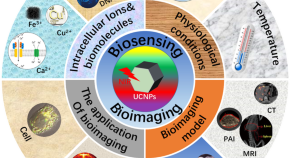Collection
Upconversion fluorescent nanomaterials for biodetection and bioimaging
- Submission status
- Closed
Traditional fluorophores including fluorescent dyes/proteins and quantum dots are based on ‘downconversion fluorescence’, converting high energy photons to low energy photons. Upconversion nanoparticles (UCNPs) present a new technology for sensitive imaging and detection in various fields. Unlike traditional fluorophores, UCNPs emit detectable high energy fluorescence in the UV/visible/NIR range upon irradiation with NIR light based on a process termed ‘upconversion’. They can be used for ultrasensitive interference-free biodetection/imaging because most biomolecules do not have this upconversion property. The major advantages of this approach include but are not limited to: multi-color, low background autofluorescence, single wavelength excitation, good photostability, and spectral unmixing. This topical collection is focused on the synthesis of UCNPs with new compositions/structures, tunable fluorescence emission and improved fluorescence intensity, and use of these nanoparticles for biodetection and bioimaging, both in-vitro and in-vivo.
Editors
-
Yong Zhang
Yong Zhang is a Provost’s Chair Professor in Department of Biomedical Engineering, National University of Singapore (NUS). His current research interests include nanobiophotonics, nanomedicine, and microfluidic devices. He has authored over 200 research papers in international journals such as Nature Medicine, Nature Communications, PNAS, and Chemical Reviews, and has delivered more than 100 Plenary/keynote/invited talks in prestigious international conferences. He is a Fellow of Royal Society of Chemistry (FRSC) and a Highly Cited Researcher named by Clarivate Analytics. Website: www.zhangnuslab.com
Articles (9 in this collection)
-
-
A novel dual-flux immunochromatographic test strip based on luminescence resonance energy transfer for simultaneous detection of ochratoxin A and deoxynivalenol
Authors (first, second and last of 9)
- Chen Chen
- Jiao Cao
- Jinliang Liu
- Content type: Original Paper
- Published: 24 November 2022
- Article: 466

-
Upconversion nanoparticle platform for efficient dendritic cell antigen delivery and simultaneous tracking
Authors (first, second and last of 9)
- Zhenfeng Yu
- Olena Vepris
- Luis J. Cruz
- Content type: Original Paper
- Open Access
- Published: 03 September 2022
- Article: 368

-
Glycosylated phospholipid-coated upconversion nanoparticles for bioimaging of non-muscle invasive bladder cancers
Authors (first, second and last of 4)
- Bowen Sun
- Sneha Sree Mullapudi
- Koon Gee Neoh
- Content type: Original Paper
- Published: 25 August 2022
- Article: 349

-
Upconversion luminescence–based aptasensor for the detection of thyroid-stimulating hormone in serum
Authors (first, second and last of 12)
- Jingrong Liu
- Chunxiao Yu
- Jianming Lan
- Content type: Original Paper
- Published: 07 April 2022
- Article: 179

-
Near-infrared mediated orthogonal bioimaging and intracellular tracking of upconversion nanophotosensitizers
Authors (first, second and last of 6)
- Yi Xiang
- Shanshan Zheng
- Xiaohui Zhu
- Content type: Original Paper
- Published: 24 February 2022
- Article: 120

-
Engineered lanthanide-doped upconversion nanoparticles for biosensing and bioimaging application
Authors (first, second and last of 4)
- Yong Li
- Chen Chen
- Jinliang Liu
- Content type: Review Article
- Published: 17 February 2022
- Article: 109

-
ZIF-8 encapsulated upconversion nanoprobes to evaluate pH variations in food spoilage
Authors (first, second and last of 9)
- Jinmei Wu
- Qi Lu
- Qingsong Mei
- Content type: Original Paper
- Published: 07 February 2022
- Article: 87

-
Rationally designed upconversion nanoparticles for NIR light-controlled lysosomal escape and nucleus-based photodynamic therapy
Authors (first, second and last of 5)
- Xiaokai Chen
- Yi Zhang
- Yong Zhang
- Content type: Original Paper
- Published: 22 September 2021
- Article: 349



